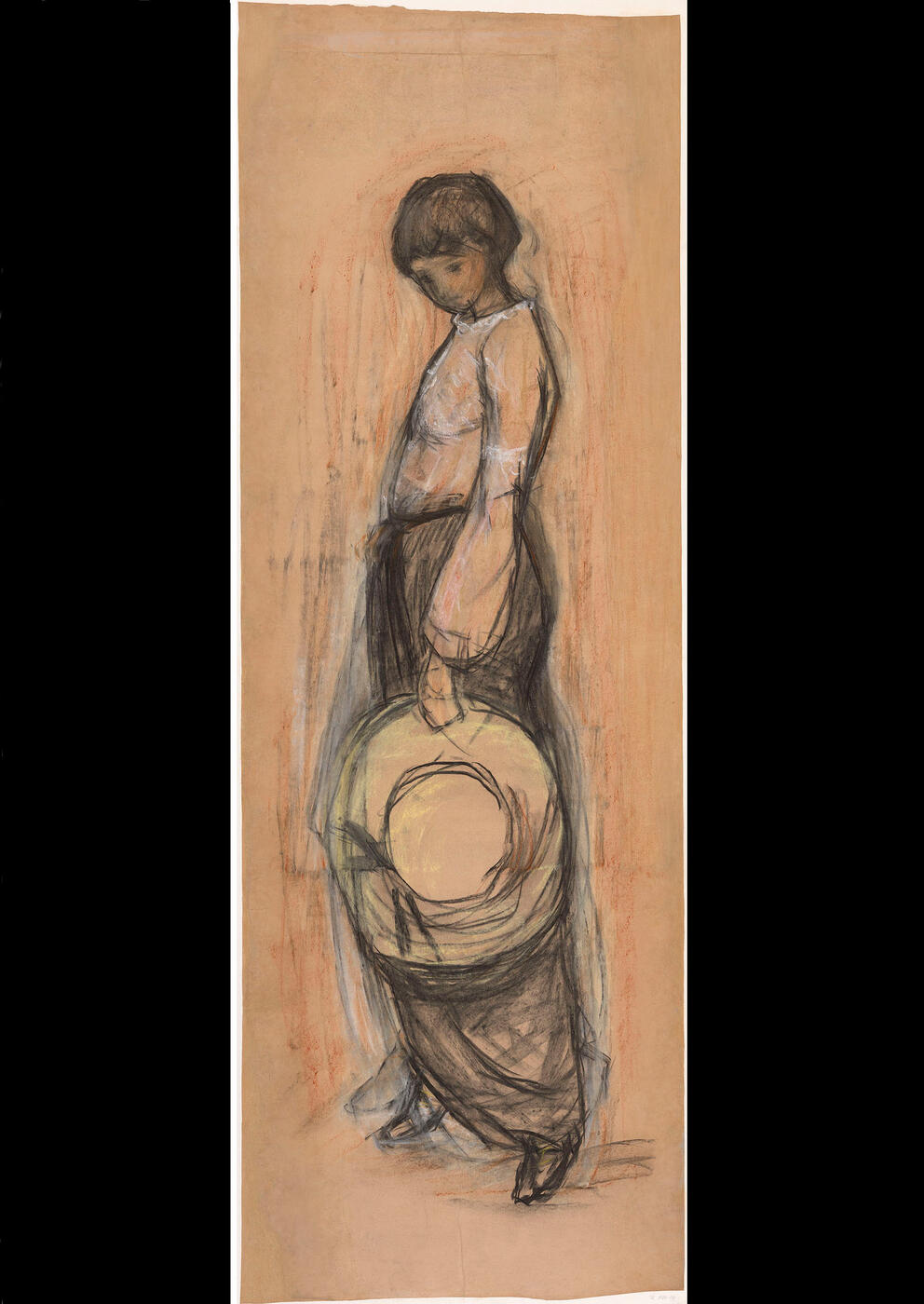MacDougall's Russian Art Auctions 1 December 2011
1 December 2011

64. GONCHAROVA, NATALIA (1881-1962)
Girl with a Straw Hat (in Profile)
Pastel and charcoal on paper, laid on card, 198 by 67 cm.
120,000-180,000 GBP
Executed in the 1900s.
Provenance: Collection of the architect N. Vinogradov, Moscow.
Thence by descent.
Collection of E. Ovsyannikova, Moscow.
Private collection, UK.
Authenticity of the work has been confirmed by the expert O. Glebova.
Literature: Natalia Goncharova. Gody v Rossii, St Petersburg, Palace Editions, 2002, p. 316, illustrated; p. 320, No. 6, listed.
These two enormous, larger than life-size, female portraits on paper by Natalia Goncharova were formerly in the collection of the artist’s friend and colleague, the architect Nikolai Vinogradov, and their appearance on the Russian art market is a singular event. For not only is their provenance impeccable but they are also among the very few drawings of the 1900s that allow us to form an idea of the early period of this artist’s work.
There is no doubt that the model for both these portraits — executed in charcoal and pastel on the reverse of lengths of wallpaper — was the same young girl, dressed in a long, black skirt and light-coloured blouse, with a straw hat in her hands. It is possible that Goncharova, as she turned the female figure to decide on the right composition, now full-face, now three-quarters view, was actually drawing herself. In any event, published photographs do exist, showing the artist in the early 1900s wearing a similar straw hat.
Today it is hard to tell what the actual purpose of these works was. However, their imposing size as well as their serious and scrupulous fidelity to nature give us grounds to suppose that Goncharova created these portraits as part of a large work she was planning. It is not impossible that they were done as life studies for one of her sculpture projects — for this celebrated artist began her artistic career at the Moscow School of Painting, Sculpture and Architecture in the sculpture class of Paul Troubetzkoy, where she made several full-figure relief friezes, now known only from archive photographs.
At this time, Goncharova abandoned sculpture because three-dimensional art was unable to convey “the play of light and the harmony of colour” about which she was so passionate, and quite early on she began working in pastel. For her this was a period of assimilation of the lessons of Impressionism, and she now painted several whole series of pastels. Unfortunately, only a few remnants of these cycles have survived. And yet, even from these surviving works we can judge Goncharova’s ability to exploit with the greatest expressiveness the possibilities and qualities specific to this medium. The vibrant, but translucent layers of pigment through which the paper shows, the slightly imprecise lines of the drawing and the vague contours have all created a strongly Impressionist feeling of instability, inconstancy and mobility in the light and air.
The style is fluid. The face, neck and torso are vigorously “sculpted” in black. In places the charcoal is over-painted with pale pink, yellowish and white pastel. It is worth noting that Goncharova not only shows a preference for traditional charcoal techniques, creating volume by hatching and stippling, but is also keen to emphasise her contour, using the line as her basic means of expression.
In this we can make out the influence of Art Nouveau and of the latest French art trends, which played a crucial role in her development as an artist. Both Goncharova and her first biographer Ilya Zdanevich referred to the early period of her career, up to and including 1906, as “a period of Impressionism and of the application of colours”, for Goncharova’s aesthetic tastes — and those of most young painters of her generation — were to a great extent influenced by the preferences of the collectors Shchukin and Morozov.
The portraits now offered for auction are from an artist who has already come to sense “painterliness” as an essential and integral quality of her talent. It is no coincidence that such works, executed with a dynamic “Impressionist” line and drawn from life, offer us a glimpse of that elusive moment of Goncharova’s approach towards the avant-garde, which is not easy to distinguish in her paintings on canvas of the same period.
Notes on symbols:
* Indicates 5% Import Duty Charge applies.
Ω Indicates 20% Import Duty Charge applies.
§ Indicates Artist's Resale Right applies.
† Indicates Standard VAT scheme applies, and the rate of 20% VAT will be charged on both hammer price and premium.